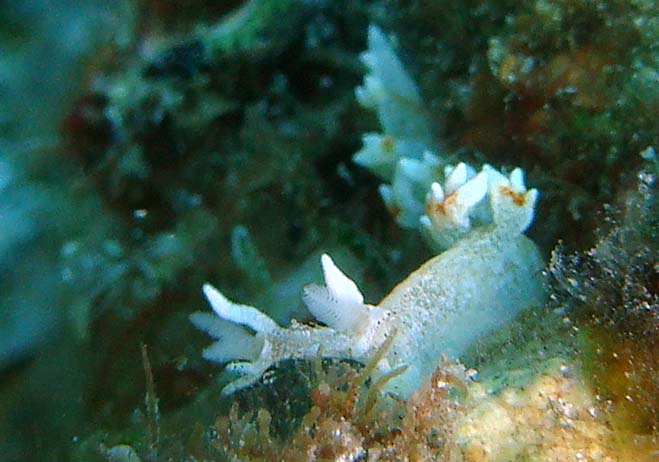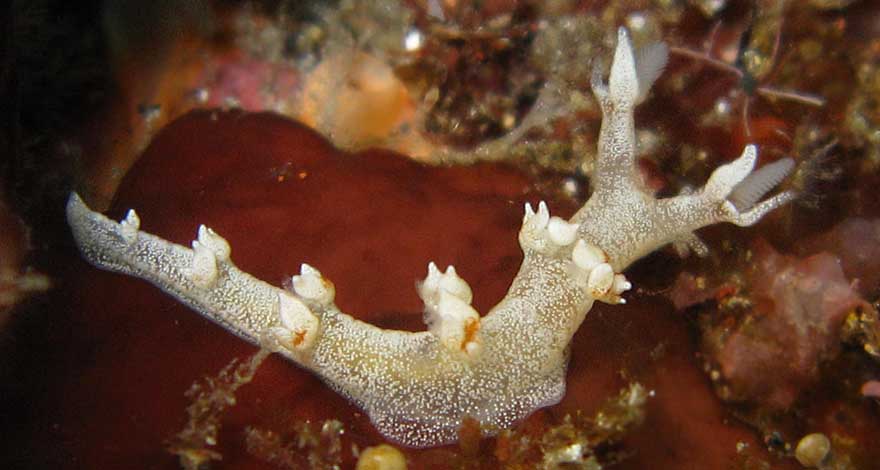This species has been observed on Reunion Island
Species characteristics : The background is translucent straw white with whitish spots and patches of varying sizes scattered all over the body wall. In some specimens, a faint, diffuse orange reticulation is visible around the whitish patches. |

|
|
| Showing species characteristics... | Photo Emmanuel Eby Saint Leu, 2 October 2005, size 25-30 mm |
|
Remarks :
Identification confirmed by Bill Rudman
Synonymous : (according Worms)
- No other name
Bibliographic data :
The animal has an elongate shape typical of species of Bornella, with lobe-like digitate oral tentacles on each side of the mouth, a pair of large elongate rhinophore sheaths and a series of paired dorso-lateral processes down the body.
The background color is a translucent straw colour with the to orange-brown viscera showing through. Epidermal and sub-epidermal white spots and patches of varying sizes are scattered all over the body wall. In some specimens, a faint, diffuse orange reticulation is visible around the whitish patches.
The oral tentacles on each side of the mouth are lobe-like and have up to 9 finger-like papillae arranged along the margin.
The rhinophore stalks are relatively large with 3 or 4 small papillae placed around the front and sides of the rhinophore sheath and a large unbranched posterior papilla, which when extended, is about three times taller than the other papillae. The rhinophore complex is coloured as the rest of the body except that the tall posterior papilla on each sheath, is mostly white. The rhinophores are translucent white with a minute orange tip
There are five to six pairs of dorso-lateral processes, with one or two small, unpaired processes near the tail. The first dorso-lateral process on each side has two or three secondary papillae on the outer side while the second and third processes on each side have a single outer secondary papillae. Behind these there are no secondary papillae.
Small tripinnate gills can occur on the inner surfaces of all processes, but can be absent, and usually are smaller on the posterior ones.
Although Bornella johnsonorum is very similar to B. stellifer, external and internal features can distinguish both species. In color, Bornella johnsonorum lacks the orange subapical rings found on the papillae of the oral tentacles, rhinophore sheaths and dorso-lateral processes of B. stellifer. Internally, there are differences in aspects of the radula, alimentary canal and reproductive system.
References :
Bill Rudman Seaslug site : Sea Slug Forum : Bornella johnsonorum
Publications :
Pola, M., Rudman, W. B. & Gosliner, T. M. (2009) Systematics and preliminary phylogeny of Bornellidae (Mollusca: Nudibranchia: Dendronotina) based on morphological characters with description of four new species. Zootaxa , 1975, 1-57.
Other photos of Bornella johnsonorum :
Emmanuel Eby Saint Leu, 2 October 2005, size 25-30 mm Detail of the rhinophores and the oral tentacle.
The oral tentacles on each side of the mouth are lobe-like and have up to 9 finger-like papillae arranged along the margin. The rhinophore stalks are relatively large with 3 or 4 small papillae placed around the front and sides of the rhinophore sheath and a large unbranched posterior papilla, which when extended, is about three times taller than the other papillae. The rhinophore complex is coloured as the rest of the body except that the tall posterior papilla on each sheath, is mostly white. |
 |
 |
Sophie Darnis Saint Gilles " Petit moteur", 5m, 3 November 2007, size : 15-18 mm, The lamellate rhinophores are translucent white without a minute orange tip The rhinophore complex is coloured as the rest of the body except that the tall posterior papilla on each sheath, is mostly white. |
Sully Bachel Sainte Rose, "Anse des cascades", 8-9m, 11 November 2008, size : 15 mm There are five to six pairs of dorso-lateral processes, with one or two small, unpaired processes near the tail.
|
 |
More photos from Indian Ocean
